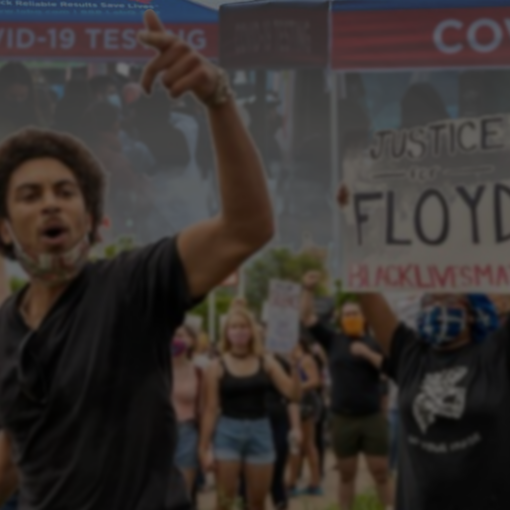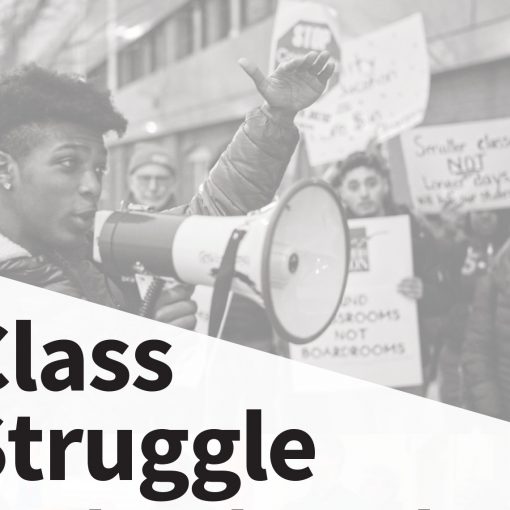Download the Pamphlet PDF version of this document for printing.
By Freedom Road Socialist Organization
May 2006
By all accounts, the Third International paid close attention to the development of the communist movement in the United States, and in doing so it made real contributions to practical and theoretical efforts of the Communist Party USA. Without the timely attention of the Communist International, it is unlikely that the deep divisions that existed in the U.S. communist movement following World War I would have been overcome. Overcoming those differences led to the establishment of a unified communist party in the early 1920s.1
Likewise, the Communist International played a critical role in shaping how U.S. communists viewed the special oppression visited upon African Americans and the resistance to that oppression. This contribution retains its relevance for today. It is impossible to understand the history of the United States, or its past and present economic, political and ideological landscape, without grasping the importance of this issue.
Social Democracy and African Americans
Prior to founding of the Communist Party USA, the Socialist Party was the dominant organization of the U.S. left. The right wing of the Party was seriously infected with white chauvinism and national chauvinism. Right-wing leaders of the Socialist Party refused to oppose (or openly supported) the ‘whites only’ restrictions that existed in a number of trade unions. The worst elements of the Socialist Party excused and soft-pedaled the lynching of Blacks, which had grown to epidemic proportions in the U.S. South. Not surprisingly, many of these same right-wing leaders of the Socialist Party would emerge as supporters of the first imperialist world war and still later show themselves to be fervent opponents of the Soviet Union.
The left wing of the Socialist Party had a more varied set of strengths and weaknesses in its approach to African American oppression. Generally speaking, the left of the Socialist Party ideologically opposed blatant white chauvinism, sometimes criticized racist discrimination in society as a whole and opposed the exclusion of Blacks from the labor and socialist movements. In the course of doing so, there were some episodes of real heroism.
But the left of the Socialist Party had an extremely serious weakness – a refusal to grasp the importance and seriousness of Black oppression, and more importantly doing very little real work to fight racist discrimination, especially when that oppression existed outside the confines of purely trade union issues.2 While the sources of the weaknesses were varied, ranging from ultra-leftism (negating the fight for reforms of any kind under capitalism) to the simple accommodation to white chauvinism, the result was exactly what one would expect: African Americans remained largely outside the organized socialist movement; the organized socialist movement had relatively little influence in the Black freedom movement; and the struggle against the U.S ruling class was weakened in the process.
Early Years of the Communist Party USA
As the Communist Party in the U.S. was formed out of the left wing that broke with the old Socialist Party, it brought with it more than a little baggage from its past, and there was distinct tendency to underestimate the importance of the struggle for Black liberation. In hindsight it is clear that this is not due to some sort of moral failure, but rather it was an issue of political line.
Throughout the early 1920s, as American communists deepened their understanding of Marxism-Leninism and interacted with the international communist movement, there was a noticeable improvement in the CP’s theoretical and practical efforts. Contributing to this steady improvement was a small but influential core of African American communists that entered the Party. 3
Some fights were organized around the demands of the African American people; mass organizations were developed among Black workers, specifically the American Negro Labor Congress, and some good agitational and propaganda work was done.
But it was not until 1928 that the CP, with assistance of the Communist International, would make a qualitative leap in its political understanding of the struggle of African Americans, thus clearing a path for a big leap forward in its work.
Lenin, the Third International, and the National Question in the U.S.
One of the many great contributions of Lenin, Stalin and the Communist International was the keen appreciation of the significance of the national and colonial question in the era of imperialism. Specifically, there is the recognition that the struggle of oppressed nations to break the chains of imperialism and colonialism are an integral part of the world revolutionary process, which is crystallized the slogan, “Workers and oppressed peoples of the world unite.”
In 1920 Lenin made it clear that the struggle of Blacks in the United States should be seen in this context, stating:
“In all their propaganda and agitation – both within parliament and outside it – the Communist parties must consistently expose that constant violation of the equality of nations and of the guaranteed rights of national minorities which is to be seen in all capitalist countries, despite their “democratic” constitutions. It is also necessary, first, constantly to explain that only the Soviet system is capable of ensuring genuine equality of nations, by uniting first the proletarians and then the whole mass of the working population in the struggle against the bourgeoisie; and, second, that all Communist parties should render direct aid to the revolutionary movements among the dependent and underprivileged nations (for example, Ireland, the American Negroes, etc.) and in the colonies.” 4 [emphasis added]
This analysis, which posits that African Americans are an oppressed nation within the borders of the U.S. and that the struggle for Black liberation should be seen as a national revolutionary movement, was rejected by, or remained largely unknown to, American communists. Rather, they remained stuck in variants of racial theory, which proved totally inadequate to explain the oppression of African Americans or to grasp the significance of fight against national oppression. 5
Harry Haywood, the brilliant African American communist who participated in the work of the Communist International, helped to develop a correct line on the Black national question in the United States and wrote extensively on how the international communist movement assisted U.S. communists in developing a Marxist understanding of this critical issue in the 1920s. His works are an invaluable resource for those who want to learn more. 6 In any event, the issue came to a head in 1928, when the Anglo American Commission of the Communist International studied the matter and came up with a resolution for its 6th Congress.
This resolution passed by the 6th Congress stated:
“While continuing and intensifying the struggle under the slogan of full social and political equality for the Negroes, which must remain the central slogan of our Party for work among the masses, the Party must come out openly and unreservedly for the right of the Negroes to national self-determination in the southern states, where the Negroes form a majority of the population. The struggle for equal rights and the propaganda for the slogan of self-determination must be linked up with the economic demands of the Negro masses, especially those directed against the slave remnants and all.”
This view was based on a concrete analysis of concrete conditions. Namely, following the U.S Civil War, which ended with the defeat of the southern slaveholders, the bourgeois revolution was never completed. Instead, after the betrayal of reconstruction in 1877, northern capitalists paved the way for white southern plantation owners to retake power.
The result was southern Blacks ended up locked in to a system of semi-feudal property relations (sharecropping), robbed of any sort of equality. Raw terror was used to maintain this system. With the rise of monopoly capitalism, a new nation, an African American nation, was forged in the Black Belt South. 7 The struggle to end this oppression is in fact a movement for national liberation, which includes recognition of the right to self-determination, i.e. the right of those in the national territory to independence. In the northern and western parts of the U.S., African Americans constitute a national minority that is also hit by discrimination, and full equality is a vital issue.
In 1930, the Comintern adopted another resolution, which further deepened the line. It stated:
“In the interest of the utmost clarity of ideas on this question the Negro question in the United States must be viewed from the standpoint of its peculiarity, namely as the question of an oppressed nation….”
In addition to upholding the right of self-determination and warning against pitting the demand for self-determination against the demand for full equality, the resolution offered practical advice to revolutionary Black and white workers, which is still relevant today.
The resolution states:
“They, the white workers, must boldly jump at the throat of the 100 percent bandits who strike a Negro in the face. This struggle will be the test of the real international solidarity of the American white workers.”
The implication here is that white workers need to be organizing against the national oppression of African Americans and by doing so they challenge the common enemy of all working people and help create the basis for multi-national unity. It is also a fact that revolutionary white workers are well situated to struggle against white chauvinism among white workers.
As for African Americans, the 1930 resolution states:
“It is the special duty of the revolutionary Negro workers to carry on tireless activity among the Negro working masses to free them of their distrust of the white proletariat and draw them into the common front of the revolutionary class struggle against the bourgeoisie.”
The point here is that revolutionary African Americans should struggle against narrow nationalism.
The Communist Party in the 1930s
The end of capitalist stabilization and the onset of the great depression in 1929, coupled with the leap in the Party’s understanding of the Black national question, led to a sharp struggle against white chauvinism and created the basis for the extraordinary advances in the 1930s.
In the Deep South, the Party mobilized poor farmers (sharecroppers) and the result was explosive battles. A fight against the legal lynching of nine young African Americans, the Scottsboro case, was the focus of a worldwide campaign, where hundreds of thousands were mobilized from Mississippi to Moscow. And the Communist Party made extraordinary efforts to bring more Black workers into the ranks of organized labor.
The net result was a developed base among all progressive classes in the Black community. The position of the multi-national working class was strengthened in the process, as was the communist movement.
The Problem of Revisionism and the Struggle Against It
One particular feature of revisionism in the United States has been its underestimation of the importance of the African American national movement, negating the movement’s national character and to argue there is no right to self-determination.8
When revisionism took hold of the Party in first half of the 1940s, the demand for self-determination was dropped and the CP – under the leadership of Earl Browder – liquidated itself. With the removal of Browder in 1945, the CP again stepped up its work to build the Black liberation movement and raised the demand of self-determination. When revisionism finally got the upper hand in the 1950’s, the demand for self-determination disappeared once and for all.
While Marxist-Leninists inside the Communist Party waged a serious fight to oppose revisionism on a host of questions – including a defense of a revolutionary line on the African American National Question – in the end it proved necessary to break with revisionism and to create new communist organizations. In the 1960s many of these anti-revisionists, including Harry Haywood and others who grasped the importance of the African American national movement, were able to propagate an advanced line to a new generation of communists.
The contributions made by Lenin, Stalin and the Communist International on the African American national question still retain their essential relevance today. They provide a revolutionary framework that sheds light on questions ranging from the battle against discrimination in our workplaces to examining the problem of uneven development in the U.S. South.
Recently, in aftermath of the Hurricane Katrina, Blacks were left to die on highway overpasses in New Orleans This shows, in the most graphic terms, the continued existence of national oppression and the burning need to shatter its chains. Oppressed nations within the U.S. need liberation. And over the long run, working people in the U.S. need revolution. Marxism-Leninism is a vital tool to achieve those ends.
Footnotes
1 In 1919, two communist parties came into being, the Communist Labor Party and the Communist Party. Real unity between U.S. communist organizations was archived in 1921, due in a large part to the political and organization efforts of the Communist International and its representatives dispatched to the United States.
2 William Z Foster, an outstanding founder and leader of the U.S. communist movement, offered the following summation of how the Socialist Party approached the oppression of African Americans, stating, “Whatever small part Socialists took in the struggle of the Negro people from time to time was as individuals, not as an organized Party.”
3 In the early 1920s a number of leaders and supporters of the African Blood Brotherhood, a revolutionary African American organization entered the CP.
4 V. I. Lenin Collected Works, Vol. 31, page 147, Preliminary Draft Theses on the National and the Colonial Questions for the Second Congress of the Communist International. Lenin put forward the same view in other articles, but as this one was presented to the international communist movement in a definitive way.
5 One of the most common variants of racial theory states that racial prejudice among whites is the cause of Black oppression and that it is a ruling class trick to make the workers fight amongst ourselves to the detriment of all concerned. Besides being idealist in its implication that national oppression will disappear by fighting racist ideas, this view negates the real inequality that exists due to national oppression.
6 Black Bolshevik — Autobiography of an African American Communist, by Harry Haywood, Liberator Press, 1978
7 Black Belt was initially a reference to rich soil that extends across many of the U.S southern states.
8 The right of self-determination is the right of a nation to determine its own destiny. Lenin compared it to the right of divorce, i.e. that staying together is voluntary and separating is a right. Voluntary unity is the basis for equality, and it is the kind of unity that communists strive for.
Contribution to the 15th International Communist Seminar
“Present and past experiences in the international communist movement”.
Brussels, 5- 7 May 2006
More documents are available at www.wpb.be/icm.htm




